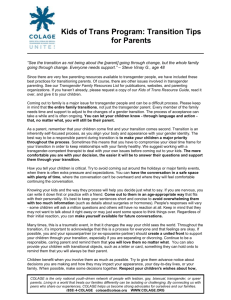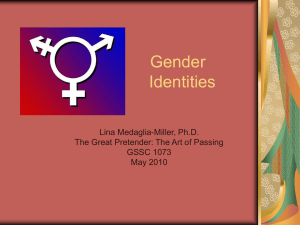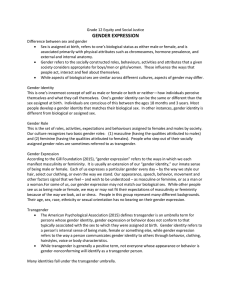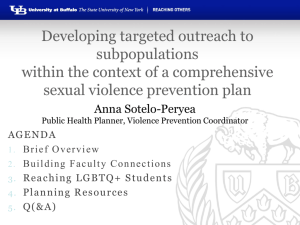T
advertisement
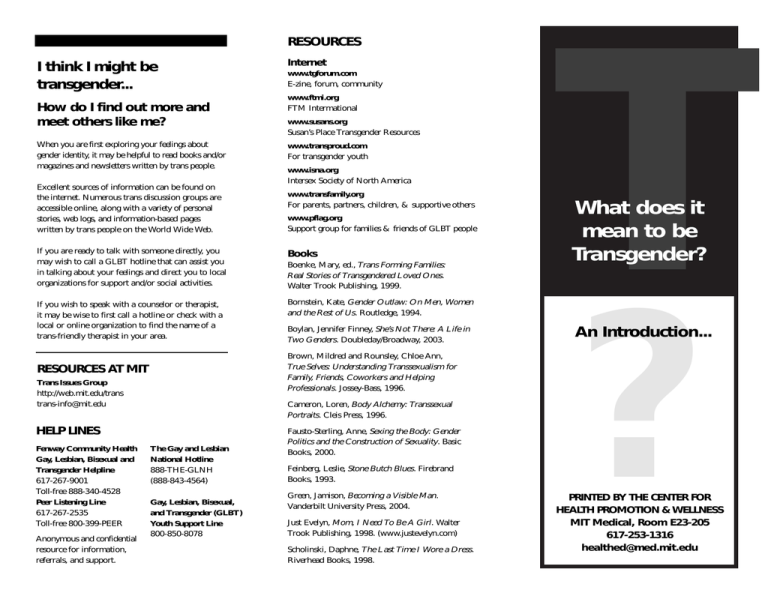
RESOURCES I think I might be transgender... How do I find out more and meet others like me? When you are first exploring your feelings about gender identity, it may be helpful to read books and/or magazines and newsletters written by trans people. Excellent sources of information can be found on the internet. Numerous trans discussion groups are accessible online, along with a variety of personal stories, web logs, and information-based pages written by trans people on the World Wide Web. Internet www.tgforum.com E-zine, forum, community www.ftmi.org FTM Intermational www.susans.org Susan’s Place Transgender Resources www.transproud.com For transgender youth www.isna.org Intersex Society of North America www.transfamily.org For parents, partners, children, & supportive others www.pflag.org Support group for families & friends of GLBT people If you are ready to talk with someone directly, you may wish to call a GLBT hotline that can assist you in talking about your feelings and direct you to local organizations for support and/or social activities. Books If you wish to speak with a counselor or therapist, it may be wise to first call a hotline or check with a local or online organization to find the name of a trans-friendly therapist in your area. Bornstein, Kate, Gender Outlaw: On Men, Women and the Rest of Us. Routledge, 1994. Trans Issues Group http://web.mit.edu/trans trans-info@mit.edu Cameron, Loren, Body Alchemy: Transsexual Portraits. Cleis Press, 1996. HELP LINES Anonymous and confidential resource for information, referrals, and support. Boylan, Jennifer Finney, She’s Not There: A Life in Two Genders. Doubleday/Broadway, 2003. Brown, Mildred and Rounsley, Chloe Ann, True Selves: Understanding Transsexualism for Family, Friends, Coworkers and Helping Professionals. Jossey-Bass, 1996. RESOURCES AT MIT Fenway Community Health Gay, Lesbian, Bisexual and Transgender Helpline 617-267-9001 Toll-free 888-340-4528 Peer Listening Line 617-267-2535 Toll-free 800-399-PEER Boenke, Mary, ed., Trans Forming Families: Real Stories of Transgendered Loved Ones. Walter Trook Publishing, 1999. The Gay and Lesbian National Hotline 888-THE-GLNH (888-843-4564) Gay, Lesbian, Bisexual, and Transgender (GLBT) Youth Support Line 800-850-8078 Fausto-Sterling, Anne, Sexing the Body: Gender Politics and the Construction of Sexuality. Basic Books, 2000. Feinberg, Leslie, Stone Butch Blues. Firebrand Books, 1993. Green, Jamison, Becoming a Visible Man. Vanderbilt University Press, 2004. Just Evelyn, Mom, I Need To Be A Girl. Walter Trook Publishing, 1998. (www.justevelyn.com) Scholinski, Daphne, The Last Time I Wore a Dress. Riverhead Books, 1998. T What does it mean to be Transgender? ? An Introduction... PRINTED BY THE CENTER FOR HEALTH PROMOTION & WELLNESS MIT Medical, Room E23-205 617-253-1316 healthed@med.mit.edu What does ‘transgender’ mean? Broadly speaking, transgender people are individuals whose gender expression and/or gender identity differs from conventional expectations based on their physical sex. (Words listed in boldface are described on the next page.) The word “transgender,” or “trans,” is an umbrella term which is often used to describe a wide range of identities and experiences, including: transsexuals, FTMs, MTFs, cross-dressers, drag queens, drag kings, two-spirits, gender queers, and many more. Is being transgender the same as being gay or lesbian? Like all other people, transgender people can be gay, straight, lesbian, bisexual, or anything in between. How each person defines and experiences their own sexuality is a highly individual process. Sexual orientation should not be assumed about anyone, transgender or otherwise! What is the cause of transgenderism? There are many theories about how gender identities are formed, including ideas based on biological processes as well as those based on upbringing and developmental psychology. But the truth is that no one really knows what causes us to feel the way we do about our genders. What is known is that different types of cross-gender and gender different behaviors and identities have been observed cross-culturally and throughout history. In some cultures, people who transgress gender boundaries have been accepted without stigma as respected community members. The use of the term “transgender,” however, is a relatively recent phenomenon. Whatever the cause, gender variant and intersex people can simply be thought of as a part of the vast complexity and diversity that is produced by nature. SOME USEFUL TERMS TO UNDERSTAND Sex The common, but imperfect, sorting of people as “male” or “female.” Sorting people by sex typically begins at birth, when (usually) a baby is declared to be either a boy or a girl. The determination of sex as “male” or “female” is almost always based on physical anatomy—the genitals— of the child. For those people whose physical sex is not easily categorized as male or female, see “intersex,” below. Intersex Everyone has a gender identity and a gender expression. Most people experience their gender identity as conforming to their physical sex. That is, most people who are born with female bodies also have a female gender identity (i.e., an internal sense that “I am a woman”), and most people who are born with male bodies have a male gender identity (i.e., an internal sense that “I am a man”). At least one in every 2,000 children is born with a sexual anatomy that is difficult to label as male or female (see www.isna.org for more specific statistics). Still other children are born with genitals that look like most boys’ or girls’ genitals, but have internal reproductive organs usually associated with the other sex. In other words, nature doesn’t always produce individuals with strictly “male” or “female” bodies. Some individuals experience their gender identity as not conforming to their physical sex (i.e., a person who is born female but does not have the internal sense that they are a woman, or a person who is born male who does not have the internal sense that they are a man). These individuals may be described as “transgender.” Many intersexed infants and children are subjected to numerous genital surgeries and hormone treatments in order to conform their bodies to the standard of either “male” or “female.” There is a growing movement to prevent such surgeries in children. A person whose gender identity does not match the sex they were assigned to at birth. Many transsexuals seek to alter their bodies through hormones and surgery. Gender A collection of traits, behaviors, and characteristics that are culturally associated with maleness or femaleness. Traits considered masculine or feminine can differ from culture to culture or in different historical periods. Examples of feminine and masculine cultural associations include: the association of “gentleness” or the color pink with the female sex, or the associations of “strength” or the color blue with the male sex. Transsexual FTM and MTF Abbreviations for “female to male” and “male to female” transgender or transsexual persons, respectively. Cross-dresser A person who enjoys dressing in clothes of the opposite sex; this may or may not also include a degree of exploration into gender identity. Drag Queens and Drag Kings A person who performs femininity or masculinity theatrically. Gender Identity Two-Spirit A person’s internal self-awareness of being either male or female, masculine or feminine, or something in-between. A term that refers to transgender traditions of some Native American cultures; such traditions varied among groups. Gender Expression The external behaviors and characteristics (i.e., dress, mannerisms, social interactions, speech patterns, etc.) that a person displays in order to indicate their gender identity. Gender expression is how someone presents their gender to the world. Gender Queer A gender-variant person whose gender identity is neither male nor female, is between or beyond genders, or is some combination of genders.

